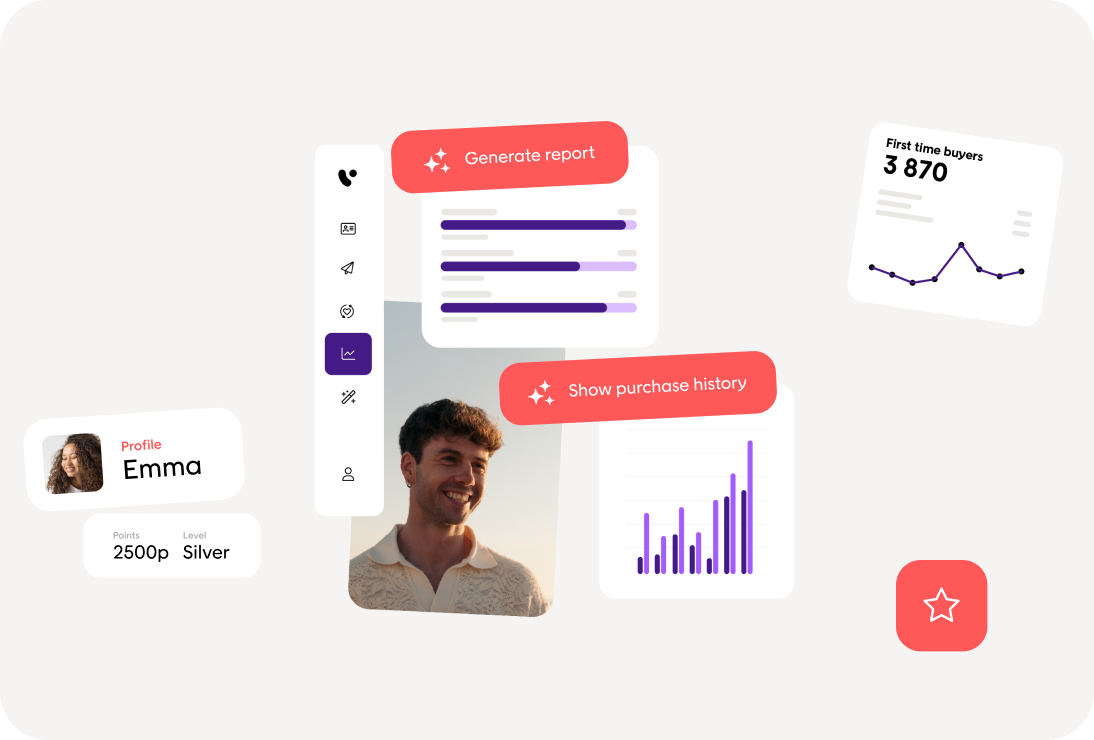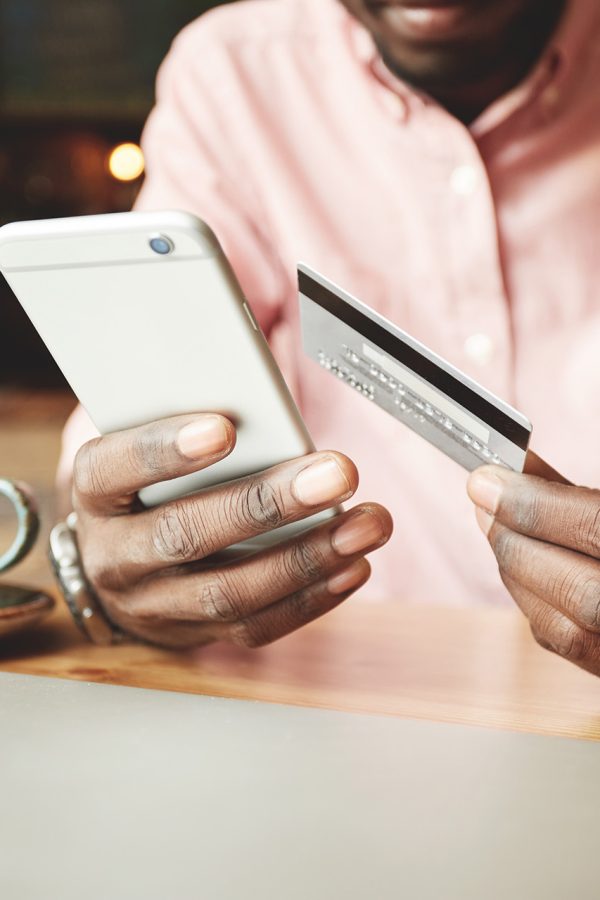Retailers today are surrounded by data, but not all of it drives results. The difference between guesswork and smart decisions lies in how you measure retail data.
When done right, data helps you understand your customers, predict their next actions, and personalize every step of their journey.
But collecting numbers isn’t enough. You need to know which data matters, how to analyze it, and how to act on it in a way that creates real value.
Here are the key takeaways:
TL;DR
- Measuring retail data is key to improving customer loyalty and growing your business
- Focus on customer-centric metrics like preferences, purchase history, and engagement
- Use tools like a customer data platform and insights, and reports to connect and analyze your data
- Learn from real-life retail examples that show how data leads to better personalization and retention
Let’s start by breaking down what retail data includes and why it matters so much.
What is retail data, and why should you care?
Retail data is any information that helps you understand how people interact with your brand. This includes what they buy, how often they shop, which products they browse, and how they respond to your messages.
But not all data is useful.
The most valuable data is customer-centric. That means data focused on your customers’ behaviors, preferences, and purchase patterns. It’s the kind of insight that helps you create personalized experiences and long-term loyalty.
When used effectively, retail data serves as the foundation for smarter campaigns, stronger relationships, and more relevant product recommendations.
Now that you know what retail data is, let’s explore which metrics matter most for your business.
The most important retail metrics
While every retail business is different, the fundamentals of measuring success remain the same.
Whether you run a cosmetics brand, a furniture showroom, or a chain of retail stores, the following metrics give you a reliable foundation for growth.
Five metrics every retailer should be tracking:
Sales figures and sales trends
Understand what’s selling, when, and why. This helps you adjust your product mix and identify what drives performance across channels.
Customer behavior
Track browsing patterns, repeat visits, and purchase triggers to inform targeted marketing strategies. This gives you insight into how shoppers move through the buying journey, both online and in-store.
Conversion rates
Whether it’s from email campaigns, point of sale, or foot traffic, knowing how many people convert helps you optimize touchpoints.
Foot traffic data
Measuring how many people walk into your store, how long they stay (dwell time), and how they move through the space reveals valuable insights about store layout, product placement, and marketing effectiveness.
Average spend
A critical indicator of profitability. It can also guide discount strategies, upsell opportunities, and special offers tailored to high- or low-spending segments.
How these metrics work: Real-world examples
- A cosmetics brand tracks customer behavior to predict when someone will need to restock. They send a timely reminder with product recommendations tailored to that shopper’s preferences.
- A furniture store monitors average spend and dwell time. After a big purchase, they follow up with care tips and suggest matching items to boost conversion rates during slow periods.
These are small, data-driven actions, but over time, they drive sales, improve retention, and make your marketing efforts far more effective.
The key is to use data not just to report on the past, but to shape future action. When you consistently track the right retail metrics, you can:
- Make more informed decisions
- Identify performance gaps across stores, channels, or customer segments
- Spot trends influenced by external factors or seasonal peaks
- Drive retail success with a clear view of what’s working and what isn’t
With your key metrics defined, the next step is to choose the right tools to measure and use them.
How to choose software that gives you a full customer view
You can’t measure retail data effectively if it’s scattered across multiple systems. To make data actionable, everything from purchases and behavior to engagement and preferences needs to connect.
Here’s what to look for when choosing the right software:
A unified customer profile
You need more than just transactions. Look for a platform that builds detailed customer profiles with:
- Purchase history
- Browsing behavior
- Loyalty data
- Communication preferences
This gives you the full picture, not just fragments.
Built-in reporting and insights
Manual exports and spreadsheets slow you down. A strong platform includes real-time insights and reports so you can:
- Track key retail metrics
- Spot customer trends
- Optimize campaigns using actual data
Easy integration and scalability
Retail environments change fast. Select software that seamlessly integrates with your existing tools and scales with your business. Your data should stay connected at every stage.
Retail-specific capabilities
Not all platforms are built for retail. Voyado is. It combines deep retail expertise with features that support every part of the customer journey, including data collection and personalized marketing.
The customer data platform gives you a complete, practical view of every customer. And it’s built to be used by marketers, not just analysts.
Once your data is unified and accessible, you can start using it to improve the customer experience.
How to use retail data to improve the customer experience
Once your data is in place, the real value comes from how you use it. Measuring retail data isn’t just about reports. It’s about creating experiences your customers truly want.
Here’s how that works in practice:
Example: Cosmetics retailer
With access to customer profiles and behavior, a beauty brand can:
- Send a reminder when a favorite product, like mascara, is likely running low
- Share new releases from a customer’s go-to brand
- Offer product recommendations based on past purchases
Each interaction feels personal, not pushy. That builds trust and keeps the brand top of mind.
Example: Furniture retailer
In a slower sales cycle, data helps in a different way:
- Follow up after a major purchase with care tips and setup guides
- Recommend complementary items, like cushions that match the new sofa
- Avoid sending offers for items the customer already owns
These touchpoints show that you understand the customer and add value beyond the sale.
Whether you’re in fast fashion or home goods, using data in a thoughtful way leads to stronger connections and repeat purchases.
But this isn’t a one-time setup. To stay ahead, data use needs to become part of your daily retail rhythm.
Make data measurement part of your retail growth cycle
One-time insights won’t get you far. To see real, long-term results, data measurement needs to become a consistent part of your retail operations. Think of it as a continuous loop, not a single step.
Here are five ways to make that cycle work:
1. Define your metrics
Start by identifying what success looks like for your business. Do you want to boost foot traffic, increase average spend, or raise conversion rates?
Some essential metrics to consider include:
- Sales figures over a specific period
- Customer behavior trends, such as dwell time or product engagement
- POS data, including the most popular payment times or basket sizes
- Foot traffic data collected from physical store entrances or shopping malls
2. Collect and connect your data
Don’t rely on manual counting or spreadsheets. Use tools that automatically track and centralize key data points, including website interactions, to in-store visits.
With a unified platform, you can:
- Connect customer profiles across online and offline touchpoints
- Track data in real time
- Eliminate data silos that slow decision-making
3. Analyze and segment
Once your data is in one place, start looking for patterns. Which products sell best during peak hours? What are shoppers doing during slow periods? Are external factors like weather or special events affecting your store traffic?
Use these insights to:
- Adjust product placement
- Plan marketing initiatives
- Identify your most valuable customer segments
4. Act on your findings
Turn analysis into action. For example:
- Create personalized offers for returning shoppers
- Launch promotions to boost sales in slow periods
- Use product recommendations to increase basket size
Every decision you make becomes smarter when it’s backed by data.
5. Measure, learn, repeat
Retail is constantly changing. That’s why it’s crucial to treat this process as a loop. Each campaign, product launch, or seasonal spike gives you new insights and a chance to improve.
Keep tracking your performance, testing new ideas, and making data-driven decisions.
When data becomes part of your daily operations, it stops being just a report and starts becoming a growth engine.
Over to you: Putting it all together
The retailers winning today aren’t the ones with the most data. They’re the ones using it to drive action.
When you measure retail data regularly, you can:
- Spot sales trends early
- Respond to external factors faster
- Create marketing initiatives that actually convert
- Make informed decisions backed by real-time insights
Whether you’re trying to boost foot traffic, increase average spend, or improve your product mix, consistent tracking helps you stay ahead, not just keep up.
Want to see how Voyado supports data-driven growth?
Book a demo and explore what’s possible.
FAQs
What’s the first step to measure retail data effectively
Start by defining your core metrics. Retailers should track sales figures, conversion rates, and customer behavior across every point of sale. It’s essential to measure success consistently to spot sales trends and make data-driven decisions that support long-term growth.
Why is foot traffic data important for retail stores?
Foot traffic data shows how many people are walking into your store during a specific period. By analyzing foot traffic data collected over time, you can identify peak hours, adjust staffing, and optimize product placement. This is crucial for increasing foot traffic and boosting sales.
How can I track foot traffic without manual counting?
Instead of relying on manual counting, modern tools use sensors, Wi-Fi, or camera-based systems to track how many people visit your store. This real-time foot traffic analysis helps you make quicker decisions and improve store performance during slow periods or special events.
How does retail data help optimize marketing efforts?
By measuring data across online and offline channels, retailers can see which marketing initiatives drive more shoppers and which need improvement. Tracking average spend, dwell time, and POS data helps businesses create actionable insights that improve targeting and boost foot traffic.
What are the benefits of taking a holistic view of retail performance?
A holistic view of your business combines data from customer behavior, external factors, and in-store performance. It helps you identify trends, determine what’s working, and stay ahead of competitors. This approach gives retailers a real advantage and supports long-term retail success.







